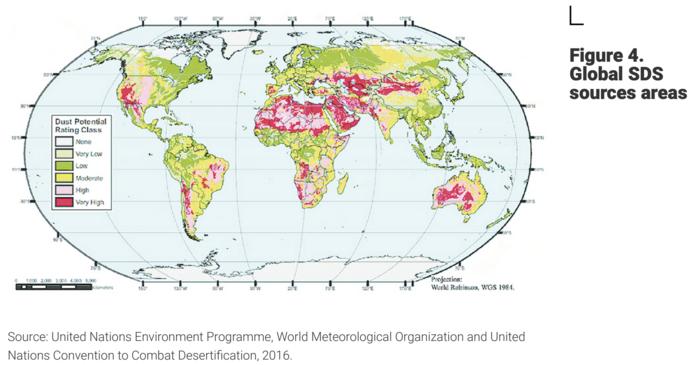Sand and dust storms – described by UN officials as “one of nature’s most intimidating spectacles” – have become dramatically more common in many world regions. While these colossal forces of nature are a seasonal natural phenomenon, up to 25 percent of them can now be attributed to human-driven factors, such as poor land management and climate change.
This week, the United Nations Convention to Combat Desertification (UNCCD) is meeting in Samarkand, Uzbekistan, to discuss their progress and the way ahead. Today, Wednesday November 15, the convention discussed ways in which the world can address the impacts of sand and dust storms on global agriculture, industry, water and air quality, and human health.
“The sight of rolling dark clouds of sand and dust engulfing everything in their path and turning day into night is one of nature’s most intimidating spectacles. It is a costly phenomenon that wreaks havoc everywhere from Northern and Central Asia to sub-Saharan Africa,” Ibrahim Thiaw, UNCCD’s Executive Secretary, said in a statement.
“Sand and dust storms present a formidable challenge to achieving sustainable development. However, just as sand and dust storms are exacerbated by human activities, they can also be reduced through human actions,” adds Thiaw.
Sand and dust storms go by many different local names: the sirocco, haboob, yellow dust, white storms, or the harmattan. They are a common meteorological hazard in arid and semi-arid regions of the world, most significantly in Northern and Central Asia, sub-Saharan Africa, North Africa, the Middle East, South America, and Australia. They can also occur anywhere in the US, most commonly in the Southwest, as well as dry regions of Europe, like Spain.

Map showing where dust and sand storms are most common in the world.
Image credit: UNCCD/UNEP/FAO
They’re kicked up by thunderstorms that lift large amounts of sand and dust from the earth into the atmosphere. Under the right circumstances, this event can cause huge trouble for the environment, infrastructure, and people’s health. Sometimes they can be fatal. National Oceanic and Atmospheric Administration (NOAA) statistics suggest there were 232 deaths from windblown dust events from 2007 to 2017 in the US alone.
In September 2009, a single dust storm event in Australia resulted in damage estimated at $229 to 243 million. Vast swathes of New South Wales and Queensland were struck by a plume of dust measuring more than 500 kilometers (310 miles) in width and 1,000 kilometers (620 miles) in length. Along with turning the skies an eerie orange color, it caused severe disruption to international flights and filled hospitals with asthma sufferers.
“The accumulation of impacts from sand and dust storms can be significant,” added Feras Ziadat, Technical Officer at the Food and Agriculture Organization of the UN and Chair of the UN Coalition on Combating Sand and Dust Storms.
“In source areas, they damage crops, affect livestock, and strip topsoil. In depositional areas atmospheric dust, especially in combination with local industrial pollution, can cause or worsen human health problems such as respiratory diseases. Communications, power generation, transportation, and supply chains can also be disrupted by low visibility and dust-induced mechanical failures,” Ziadat said.
In some parts of the world, the frequency of sand and dust storms has already doubled in the past few decades. It’s now estimated that 2 billion tons of sand and dust enter the atmosphere every year – that’s equal in weight to 350 Great Pyramids of Giza.
This kind of thing could be set to become increasingly common in many parts of the world due to poor land and water management, plus droughts driven by climate change.
To deal with the mounting problem, the UNCCD is looking to promote several measures, including land restoration, improved monitoring, and better impact mitigation.
